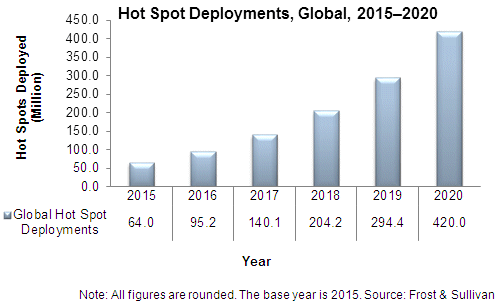Over the last year the telecommunications industry has witnessed a substantial degree of adoption of voice over LTE (VoLTE), and voice over Wi-Fi (VoWi-Fi) deployments throughout the world. This trend is likely to continue year on year. The telecommunications industry is, in particular, expected to be bullish about the implementation of VoWi-Fi in the years to come.
According to the Cisco VNI report for 2016, VoWi-Fi should experience a sustained growth rate of 93% between 2015 and 2020, as against the 63.6% proliferation rate of VoLTE network deployments during that same period. By 2020, IP traffic through VoWi-Fi should represent 52.9% of all IP-based data traffic.
VoWi-Fi, VoLTE, and VoIP Minutes of Use per Year, Global, 2015–2020

The stark difference in growth rates between the two deployments is likely attributed to the presence of a relatively vast, unlimited, and cheaper unlicensed spectrum that network operators can offload their traffic onto during a spectrum crunch. The advantage of adopting VoWi-Fi is, therefore, twofold. Its enables the network operator to provide enriched communication services to its customers without a substantial increase in capital and operating expenditures associated with procuring and managing additional network infrastructure. It also enhances the network coverage from the end-user device and affords HD voice at a lower price, regardless of roaming policies.
Revenue Forecast and Analysis by Region
VoWi-Fi’s superior voice quality is achieved through the deployment of hot spots, as well as HetNets (heterogeneous networks) from within concrete structures where cell coverage is poor. One can therefore observe a direct correlation between the VoWi-Fi rate of proliferation and the growing number of hot spots deployed in every region. In 2014, France was a leader in terms of hot spots deployed. The following year, however, the United States made a substantial push in hot spot deployments.
In 2015, an estimated 64 million hot spots were deployed across the globe. This figure should increase substantially, and by 2020 surpass 420 million. North America is a leader in terms of deployments made, and represents 34% of global deployments. The region is followed by Asia-Pacific then Europe and the Middle East, representing 31% and 26%, respectively.

Challenges Associated with VoWi-Fi Deployments and the Trends Communication Testing Equipment Market Can Bank On
The number of hot spots and HetNets deployed around the world should enhance the ubiquitous unlicensed spectrum that draws the end-user transition, justifying the growth of VoWi-Fi in those regions. However, quite a few challenges must be addressed if deployment of VoWi-Fi technology can become a ubiquitous reality. The primary concern is enhancing visibility across a spectrum that it not under the network operator’s control. This could severely impact the perceived quality of the services offered to the end-user, which could increase churn among them.
The other challenge is the handover issue associated with transitioning from a licensed spectrum to an unlicensed spectrum. The process of handovers without latency is a complex phenomenon that the network operator needs to get right during the first attempt; failure of doing so could again jeopardize the organization’s repute and ability to provide quality telecom services to the end users.
Conclusion
VoWi-Fi technology is set to witness an unprecedented rate of adoption in the near future. The substantial rate of growth is driven by a number of factors, of which the deployment of hot spots and HetNets top the list. While the advantages associated with its implementation are aplenty, numerous challenges keep pace. These challenges do, however, present innumerable opportunities for the communication testing and monitoring market to capitalize upon.



